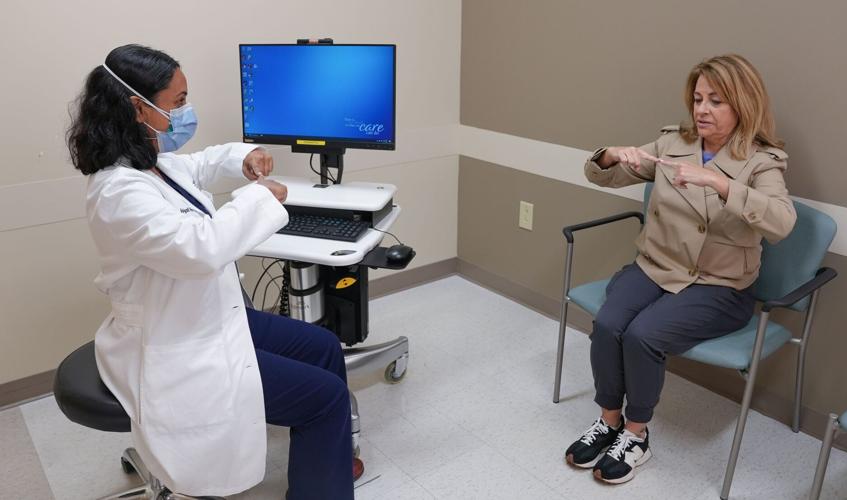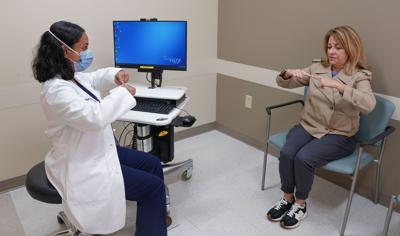The symptoms typically begin in early adulthood and become progressively more severe as one ages. What may begin as a feeling of trembling within the body can eventually become a noticeable hand tremor that gradually increases in amplitude — from a millimeter, perhaps, to a few centimeters or more. Since the condition manifests anytime the person performs an action, the shaking can make even routine movements more difficult, if not impossible.
This is essential tremor, a condition that affects about 5% of people in the U.S. over age 60.
“It becomes very hard to use utensils to eat, for instance. If peas are resting on a fork, they’ll shake off the fork,” said Abigail J. Rao, M.D., functional neurosurgeon with Norton Neuroscience Institute. “Or when the person is trying to drink from a cup, the cup will shake so much they spill the liquid on themselves. It becomes very hard to write legibly, even so bad that the person can’t keep the pen on the paper. It can become difficult to cook, type, shave, brush one’s teeth or even feed oneself. So it really can affect all aspects of daily living.”
At its worst, essential tremor can severely affect quality of life. While there’s no cure, Norton Healthcare is on the cutting edge of treatment for essential tremor, thanks to an approach called high-intensity focused ultrasound (HiFU), which uses ultrasound waves to reduce tremors by up to 70%. Norton Neuroscience Institute Cressman Parkinson’s & Movement Disorders Center is the only site in Kentucky to offer HiFU treatment.
Focused down to a pinpoint
Think of it like a magnifying glass, focusing sunlight on a single fine point capable of burning a hole in a leaf. That’s the same concept as HiFU, which concentrates ultrasound waves to a single exact point that impacts the part of the brain causing essential tremor.
Researchers have been working on the technology for over 25 years, according to Dr. Rao, trying to find ways for ultrasound waves to penetrate the skull and be focused in a controlled, effective manner. The treatment was approved in 2016.
“The power of it is in the ultrasound waves or beams that become so focused and concentrated that they actually create heat, and heat creates a lesion,” Dr. Rao said. “And so it’s that lesion that creates the clinical effect. Part of the trick, so to speak, is getting all these beams to focus down properly to a very pinpoint area.”
The patient is awake during the procedure, which does not require any incisions and takes place in an MRI machine. The patient wears a frame that holds the head very still, while surgeons focus the ultrasound waves on an area of the brain just a few millimeters in diameter. The team takes MRI scans to study the patient’s brain anatomy before creating test lesions — temporary lesions created with less heat and lower power, so they can find the exact area of the brain that needs to be treated.

When the surgeons are satisfied they have the precise location, they focus the ultrasound waves to create the permanent lesion, which changes the brain’s circuitry involving movement.
“The idea is that we’re targeting it through a specific part of the brain that seems critical to this particular disordered movement,” Dr. Rao said. “It’s not really correcting a problem or an anatomic abnormality. It’s changing the message that the brain is sending to the body.”
No incision, no anesthesia
The patient is awake during the procedure, so surgeons can have them perform motions — pretending to drink from a cup, for instance — to test the degree of tremor relief. That means the HiFU treatment can be effective immediately and can reduce tremors by as much as 70%.
“Relief can vary from patient to patient, and some patients go into it with a much more severe tremor than others,” Dr. Rao said. “But with 70% effectiveness, pretty much all patients who have HiFU treatment will say it was plenty enough for them to now resume the things they were having trouble doing and improve their quality of life.”
Not only is Norton Neuroscience Institute the only center in Kentucky offering HiFU treatment for essential tremor, it’s one of the first locations in the country to implement the new Exablate Prime HiFU technology, which was introduced in 2024 and allows for a quicker and more focused procedure. There’s no incision, anesthesia or hospital stay in typical cases; and most patients go home immediately after the two-hour procedure.
The patient does have to have their head shaved because hair can contain air bubbles that are capable of disrupting the ultrasound beams.
“The concept here is that many hundreds of ultrasound beams are coming through the skull, and we’re trying to focus them down, so they need to go through this pathway and not be scattered or disrupted,” Dr. Rao said. “That’s why the hair has to be shaved for the procedure. But unlike what you may think of as traditional surgery, there’s no incision. Nothing penetrates the skull apart from the invisible ultrasound waves.”
Are you or a loved one living with essential tremor and interested in learning more about HiFU treatment? Call Norton Neuroscience Institute’s focused ultrasound program at (502) 671-9489, view Norton Neuroscience Institute locations throughout Kentucky and Southern Indiana, or visit their webpage at NortonHealthcare.com/HiFU.













